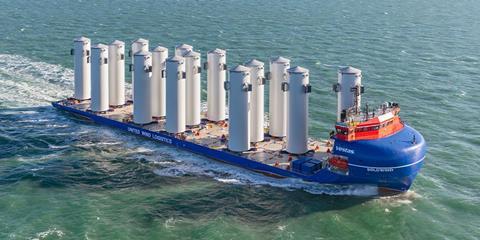DNV has created a class notation for deck carriers, which it hopes will accelerate the classification process for such vessels.

Deck carriers have become a mainstay of the market when it comes to handling very large wind turbine components.
Since no existing ship class described these vessels adequately, DNV said they had to be classed individually in the past. “The deck carrier ship type notation defines specific requirements for these vessels,” explained Jan Rüde, ship type expert MPV, hull structure and outfitting at DNV. “It covers typical features, such as a front deckhouse, a large, open deck space, the absence of a cargo hold, and strong hull and deck reinforcements. There are specific constraints for operation when loaded, such as acceleration limits, maximum wave height and weather conditions.”
Any additional features, such as dynamic positioning or a semi-submersible design, can be addressed by adding suitable class notations if desired, he added.
The classification society believes that the new notation clears the way for tackling the unique transport challenges that comes with wind energy. “On conventional multipurpose vessels, cargo cannot be stacked very high on deck because it will obstruct the line of sight from the bridge in the aft section. This is why the superstructure on a deck carrier is positioned at the front, with the cargo behind it,” Rüde pointed out. “What is more, hatch covers on most multipurpose vessels are not strong enough to support the weight of several sets of blades or very heavy wind turbine components.
“Deck carriers are designed specifically for this cargo,” he continued. “The simplicity of this design makes them relatively inexpensive and easy to load, ensuring fast turnaround in port and lower port and freight costs.”
The first vessels bearing DNV’s deck carrier class sign, BoldWind and BraveWind, are both owned by United Wind Logistics (UWL) and operated by Vestas on long-term charter, primarily between the Vestas rotor blade factory in Nakskov, Denmark, and various European ports or wind farm sites.
“These ships use the available space very efficiently,” said Captain Philipp Tietjen, managing director at United Engineering Solutions (UES), the sister company of UWL specialised in heavy lift operations engineering. “Whether jackets, monopiles, tower sections or rotor blades – these ships can carry large items that would not fit into the cargo hold of a conventional multipurpose vessel.”
















